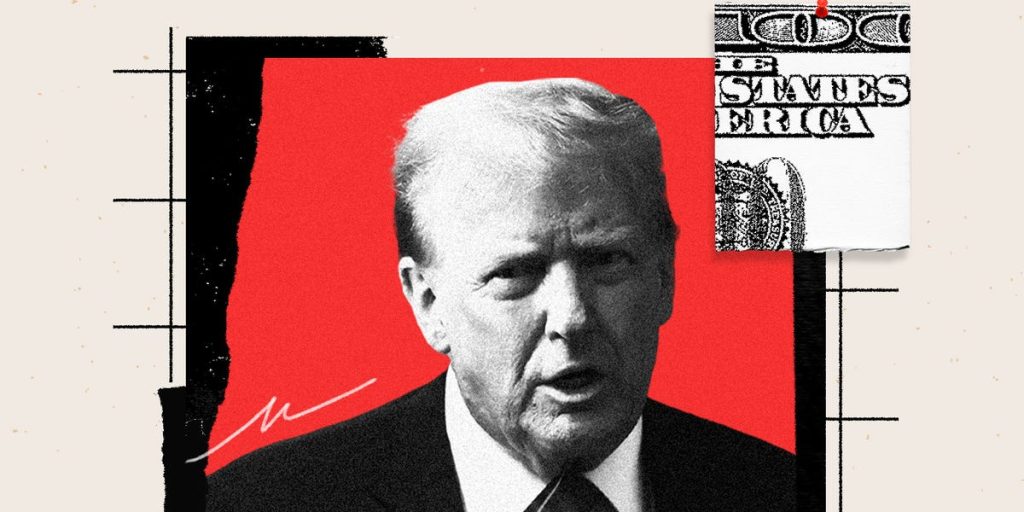The Ripple Effects of Trump’s Tariffs on Global Markets
1. Introduction to the Tariffs and Initial Reactions
The imposition of tariffs by the Trump administration on key trading partners—Canada, Mexico, and China—unleashed a wave of uncertainty across global markets. These tariffs, set to take effect in phases, targeted imports from these countries with varying rates, causing immediate and significant market reactions. The tariffs were not just economic measures but also political moves, reflecting ongoing trade tensions and strategic negotiations. The delay of the Mexican tariff after a bilateral agreement highlighted the interplay between economic and diplomatic strategies. Markets responded with stocks and cryptocurrencies declining sharply, while the US dollar and oil prices surged, underlining the complex interconnections of global trade and finance.
2. The Impact on Stocks and Corporate Earnings
The financial markets experienced notable volatility, with major indices such as the S&P 500 and Nasdaq 100 witnessing declines of 1.8% and 2.2%, respectively. This downturn was not isolated to US markets, as international indices in Japan, South Korea, Australia, the UK, and Europe also suffered losses. Tech stocks, including giants like Nvidia, Broadcom, Apple, and Alphabet, were particularly affected, with Nvidia’s stock dropping nearly 6%. The root of this concern lies in the potential inflationary impact of tariffs, which could lead to tighter monetary policies. Goldman Sachs predicted a possible 5% drop in the S&P 500, signaling a challenging environment for corporate profitability and investor confidence.
3. The Automotive Industry: A Harsh Reality Check
The automotive sector faced significant headwinds, with companies like Tesla and Ford experiencing stock declines of 7% and 5%, respectively. This sector’s vulnerability stems from its complex, cross-border supply chains, especially between the US, Canada, and Mexico. Analyses suggest that tariffs could increase car prices by approximately $3,000, potentially deterring sales and squeezing profit margins. The impact on profitability is compounded by the likely consumer response to higher prices, raising concerns about the broader economic implications for both manufacturers and consumers.
4. Cryptocurrency Markets: Turmoil and Volatility
The cryptocurrency market, often seen as a refuge during economic uncertainty, also felt the tremors of the tariffs. Bitcoin’s value dropped 6%, while Ethereum and Dogecoin experienced more severe declines of 27% and 25%, respectively. The correlation between Bitcoin and the tech-heavy Nasdaq 100 index was evident, as the cryptocurrency’s price movements mirrored the equity market’s volatility. The drastic fall in Ethereum was exacerbated by leveraged positions, leading to forced liquidations. This underscores the interconnectedness of traditional financial markets and cryptocurrencies, challenging the notion of crypto as a safe haven during market instability.
5. The Strengthening Dollar and Soaring Oil Prices
In contrast to the declines in stocks and cryptocurrencies, the US dollar and oil prices saw significant gains. The US Dollar Index rose approximately 1%, while the Canadian dollar and Mexican peso each fell about 1% against the dollar. This surge was driven by expectations of higher interest rates stemming from potential inflation, making dollar-denominated assets more attractive. Oil prices also climbed, with US crude spiking 4%, as the tariffs highlighted the US’s reliance on Canadian and Mexican oil imports. This not only affected energy prices but also raised concerns about energy security and geopolitical tensions.
6. Broader Economic Implications and Future Outlook
The tariffs’ imposition signals a possible resurgence of trade tensions, with multifaceted implications for the global economy. While some sectors may adapt by restructuring supply chains or exploring alternative markets, the immediate impact on consumer prices, corporate profitability, and investor sentiment is undeniable. The Federal Reserve’s potential response, including tighter monetary policies, could further shape the economic landscape. As markets navigate this uncertainty, the interplay between inflation, interest rates, and trade policies will remain critical factors influencing economic stability and recovery prospects. The challenge for policymakers and businesses alike will be to mitigate these impacts while seizing opportunities for growth in an increasingly complex global trade environment.







